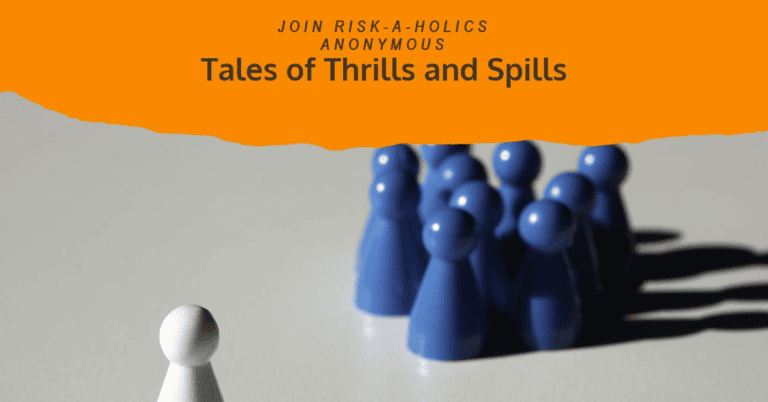Ah, business management. The subtle art of keeping everything floating while juggling flaming torches and unicycling on a tightrope.
Ok, it’s not quite that dramatic, but it can feel like it when you are in the thick of things, riskonomically speaking. Welcome to the pun-filled world of Riskonomics, where going through various ups and downs is all part of the day’s routine.
The Delicate Dance of Risk and Reward
At its core sits a potentially contentious axis, reflecting the inevitable balance of risk and reward that underpins every decision made in business management. Is it worth the risk to launch that new product? To open up a new market? Revamp current operations?
Imagine you run a bakery. Somebody tells you that gluten-free products are catching on. Should you risk some investment in gluten-free ingredients and recipes, alienating your faithful wheat-loving clientele? Or stick with tried-and-true recipes, missing the lucrative new market? That’s the essence of risk management: betting on possible rewards – and potential pitfalls.
The Risk Matrix: Your New Best Friend
The risk matrix is there to offer interpretive guidance for these nebulous depths. Draw two axes. On the one hand, things might be measured in terms of the probability of the risk occurring; on the other hand, they might be measured in terms of the magnitude of the consequences, should they occur. Risks that are serious and probable lie in the danger zone; trivial and improbable risks lie safely elsewhere.
If the bakery judges a gluten-free line as highly likely to succeed and have a high potential impact, it will be placed in the risk matrix’s ‘Go for it!’ area.
The Pun-ny Side of Business
Let’s lighten the mood now with a few not-so-serious puns, as the business doesn’t have to be all serious. It could be fun sometimes. Puns are an excellent way to develop a friendly culture in the company while reducing the stress levels of colleagues. Business-oriented puns can enhance your day, such as – The Fishy Accountant: Balancing the books? It’s a ‘whale’ of a time. If a little good-humoured ribbing makes employees enjoy their jobs more and keeps them smiling when times get tough, it can’t hurt.
Puns: The Glue of Company Culture
But when it comes to managing businesses, why do puns matter? Well, they can be the stuff that cultures are made of. A company that allows humour and lightness can better cope with challenges and change.
Take the online shoe retailer Zappos. While it’s a serious business, its strangely cheerful culture with a core value of ‘Create Fun and A Little Weirdness’ makes it a wonderful place to work and a great place to recruit people whose attitude is a good fit.

Risk Management Strategies: Your Toolkit
Now, here are some practical risk management tools. These are the elements that will help you cycle those tightropes with style.
Risk Avoidance: the most straightforward approach. If something looks too dangerous, don’t do it, but be wary: conservatism can choke innovation. Never leave the shore; a storm will wipe you out; never leave the shore, then you won’t discover a new continent.
Risk Reduction: means taking steps to reduce the size or frequency of your risk. Our bakery might reduce risk by starting small—perhaps by offering a limited gluten-free menu—to see if anyone is interested before going all in.
Risk sharing: two heads are better than one. So, what’s the solution to risk? Consider the bakery. A joint venture with a gluten-free cake supplier might offset some financial risk by not holding two types of flour.
Risk Retention: sometimes you have to take it. This might be your only choice, but it’s more likely your best choice if the rewards are big enough, So brush up on your risk-taking skills. This is what it means to be an entrepreneur – another way of saying there’s no reward without risk.
The Balancing Act: Case Studies
Let’s look at a couple of real-world examples of Riskonomics in action.
Case Study 1: Apple Inc.
For instance, consider Apple, which launched the iPhone into the smartphone market. The risk appeared more significant than the possible rewards. Yet, the company managed the risk through R&D, quality, and marketing to create one of the most successful bets in technology history.
Case Study 2: Blockbuster
Meanwhile, take Blockbuster. The company was presented with endless opportunities to shed business-model risk, embracing digital streaming early on in contrast to Netflix. However, the change risk was avoided, and Blockbuster went out of business. The other side of risk-aversion is being too risk-averse, ignoring opportunities for change in your industry that could make or break you.
Final Thoughts
And there you go. Riskonomics is about balancing risk and reward while having fun. It involves leveraging the risk matrix, applying effective risk management techniques, and creating a culture that cultivates humour and improvisation.
All business decisions involve trade-offs. If we approach them with the right balance of pragmatism and wit, we can turn our risky ventures into happy profits.






